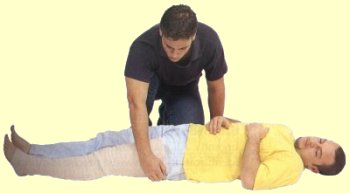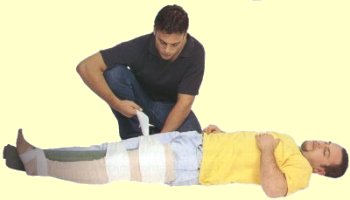

The pressure/immobilisation method is now widely used as a simple and effective way of slowing the spread of poison throughout the body. This method involves placing a firm but not tight, bandage along the entire limb that has been bitten or stung. This compresses the tissue, thus reducing the flow of venom along the limbs. Quite often the venom will be trapped exactly where it enters the body.

The patient should be kept calm and rested; all undue movement should be avoided. The pressure/immobilisation bandage should be applied. If the bite is on a limb the the current St Johns first Aid method should be used. If you are not familiar with the current method, contact the St Johns Ambulance Service immediately.

If it is necessary to immobilise, then a second bandage can be applied to immobilise the effected limb using a splint. this is usually done after the effected limb has had the pressure bandage applied. Seek Medical Aid immediately, it is better to send for an Ambulance rather than transport the casualty.
FUNNEL-WEB SPIDER
The Funnel-web Spider is the cause of much anxiety along the East Coast of New South Wales. Many people still believe that a bite from this creature means death within minutes. This quite wrong. Many people also believe that the larger female of the species is more deadly; in fact it is the male that is more dangerous. As long as the pressure/immobilisation method is applied, the chances of death are very slight.
Unlike snake bites, the casualty feels great pain at the site of the bite. Nausea and abdominal pain follow. The casualty will alsop experience difficulty in breathing and a general weakness or numbness of the muscles. The body also secretes heavily in several areas. Profuse sweating is usually obvious, along with excessive saliva production. Heavy coughing, producing secretions is common.
Now that all major hospitals in "Funnel-web Country" carry an effective antivenene, there is little risk of death resulting from a bite. Once the pressure/immobilisation method has been applied and medical aid sought, a few days in the hospital is the usual outcome with no lasting damage.
RED-BACK SPIDER
As the venom of the Red-back Spider moves very slowly, any attempt to restrict its progress would only serve to increase the associated pain. No restrictive bandage should be applied, check with your local St Johns Ambulance for the current method for this particular spider bite. The fangs of this spider are quite and its bite may often go unnoticed, but, often a sharp pinprick may be felt. This is followed by pain at the site of the bite, leading to more general pain. Other symptoms include nausea, dizziness and partial loss of muscle control.
Sweating occurs in varying degrees, and is sometimes apparent around the site of the bite. Swelling of the affected area is common, as is a quickening of the heartbeat.
As with other bites, the casualty should be kept calm and reassured. Check with your local St Johns Ambulance on the current First Aid for this particular spider bite. Where possible, take the spider to the hospital for identification. Medical First Aid should be sought immediately and many hospitals carry an effective antivenene for the Red-back Spider.